Effect of Shear Bands Induced by Asymmetric Rolling on Microstructure and Texture Evolution of Non-Oriented 3.3% Si Steel
Abstract
1. Introduction
2. Experimental Procedure
3. Results
3.1. Microstructure
3.1.1. Microstructure after Rolling without Annealing
3.1.2. Microstructure after Annealing
3.2. Texture
3.2.1. Texture after Rolling without Annealing
3.2.2. Texture during Recrystallization
3.2.3. Texture Comparison after Complete Recrystallization
4. Discussion
4.1. Effect of Rolling Mode on the Microstructure after Rolling and Annealing
4.2. Analysis of Texture Evolution after Asymmetric Rolling and Annealing
5. Conclusions
- (1)
- Compared with the SR sample, the shear bands in the ASR sample are more abundant. The shear bands have a larger inclination angle with the RD, generally around 40°. In addition, the surface and sub-surface layers of the ASR sample have obvious grain fragmentation.
- (2)
- After annealing at 650 °C, the recrystallization fraction of the ASR sample reaches 62%, which is significantly higher than that of the SR sample (30%). Moreover, when increasing the annealing temperature, the rate of increase of the recrystallization fraction decreases.
- (3)
- Compared with the SR, the ASR only changes the strength of the texture components; especially, the strength of the γ-fiber texture is enhanced. No new components are observed. There are also great differences in the evolution of texture in different layers in the ASR sample. After annealing at 650 °C, the nucleation of Goss- and cube-oriented grains is inhibited at the surface layer, while Goss- and cube-oriented grains are nucleated in the center layer. However, after annealing at 750 °C with complete recrystallization, the surface layer completely consists of η-fiber-oriented grains, while the central layer is dominated by the γ-fiber-oriented grains.
- (4)
- After annealing at 850 °C, the through-thickness grain orientation in the ASR sample is mainly η-fibers. Both the γ-fibers as the main texture and η-fibers as the subsidiary texture coexist in the SR sample. Thus, the ASR can significantly increase the strength of η-fibers.
Author Contributions
Funding
Conflicts of Interest
References
- Zhang, Y.; Lan, M.-F.; Wang, Y.; Fang, F.; Lu, X.; Yuan, G.; Misra, R.; Wang, G.-D. Microstructure and texture evolution of thin-gauge non-oriented silicon steel with high permeability produced by twin-roll strip casting. Mater. Charact. 2019, 150, 118–127. [Google Scholar] [CrossRef]
- Jiao, H.; Xu, Y.; Zhao, L.; Misra, R.; Tang, Y.; Zhao, M.; Liu, D.; Hu, Y.; Shen, M. Microstructural evolution and magnetic properties in strip cast non-oriented silicon steel produced by warm rolling. Mater. Charact. 2019, 156, 109876. [Google Scholar] [CrossRef]
- Liu, H.-T.; Schneider, J.; Li, H.-L.; Sun, Y.; Gao, F.; Lu, H.-H.; Song, H.-Y.; Li, L.; Geng, D.-Q.; Liu, Z.-Y.; et al. Fabrication of high permeability non-oriented electrical steels by increasing <001> recrystallization texture using compacted strip casting processes. J. Magn. Magn. Mater. 2015, 374, 577–586. [Google Scholar] [CrossRef]
- Park, J.-T.; Szpunar, J.A. Texture Development during Grain Growth in Nonoriented Electrical Steels. ISIJ Int. 2005, 45, 743–749. [Google Scholar] [CrossRef]
- Sidor, J.; Verbeken, K.; Gomes, E.; Schneider, J.; Rodriguez-Calvillo, P.; Kestens, L. Through process texture evolution and magnetic properties of high Si non-oriented electrical steels. Mater. Charact. 2012, 71, 49–57. [Google Scholar] [CrossRef]
- Wu, S.-Y.; Lin, C.-H.; Hsu, W.-C.; Chang, L.; Sun, P.-L.; Kao, P.-W. Effect of Heating Rate on the Development of Annealing Texture in a 1.09 wt.% Si Non-oriented Electrical Steel. ISIJ Int. 2016, 56, 326–334. [Google Scholar] [CrossRef]
- Xie, L.; Yang, P.; Zhang, N.; Zong, C.; Xia, D.; Mao, W. Formation of {100} textured columnar grain structure in a non-oriented electrical steel by phase transformation. J. Magn. Magn. Mater. 2014, 356, 1–4. [Google Scholar] [CrossRef]
- Paolinelli, S.D.C.; Da Cunha, M.A.; Cota, A.B. The influence of shear bands on final structure and magnetic properties of 3% Si non-oriented silicon steel. J. Magn. Magn. Mater. 2008, 320, e641–e644. [Google Scholar] [CrossRef]
- Shi, C.; Jin, Z.; Ren, H.; You, J. Effect of lanthanum on recrystallization behavior of non-oriented silicon steel. J. Rare Earths 2017, 35, 309–314. [Google Scholar] [CrossRef]
- Fang, F.; Lan, M.-F.; Lu, X.; Zhang, Y.; Wang, Y.; Yuan, G.; Cao, G.; Xu, Y.; Misra, R.; Wang, G.-D. The impact of niobium on the microstructure, texture and magnetic properties of strip-cast grain oriented silicon steel. J. Magn. Magn. Mater. 2017, 442, 1–7. [Google Scholar] [CrossRef]
- Cardoso, R.F.D.A.; Brandao, L.; Da Cunha, M.A. Influence of grain size and additions of Al and Mn on the magnetic properties of non-oriented electrical steels with 3 wt. (%) Si. Mater. Res. 2008, 11, 51–55. [Google Scholar] [CrossRef]
- Lan, M.-F.; Zhang, Y.-X.; Fang, F.; Lu, X.; Wang, Y.; Yuan, G.; Cao, G.-M.; Misra, R.; Wang, G.-D. Effect of annealing after strip casting on microstructure, precipitates and texture in non-oriented silicon steel produced by twin-roll strip casting. Mater. Charact. 2018, 142, 531–539. [Google Scholar] [CrossRef]
- Sahoo, G.; Singh, C.; Deepa, M.; Dhua, S.; Saxena, A. Recrystallization behaviour and texture of non-oriented electrical steels. Mater. Sci. Eng. A 2018, 734, 229–243. [Google Scholar] [CrossRef]
- Ushioda, K.; Hutchinson, W.B. Role of shear bands in annealing texture formation in 3% Si-Fe (111)[112] single crystals. ISIJ Int. 1989, 29, 862–867. [Google Scholar] [CrossRef]
- Park, J.-T.; Szpunar, J.A. Evolution of recrystallization texture in nonoriented electrical steels. Acta Mater. 2003, 51, 3037–3051. [Google Scholar] [CrossRef]
- Fang, F.; Zhang, Y.; Lu, X.; Wang, Y.; Lan, M.; Yuan, G.; Misra, R.; Wang, G. Abnormal growth of {100} grains and strong Cube texture in strip cast Fe-Si electrical steel. Scr. Mater. 2018, 147, 33–36. [Google Scholar] [CrossRef]
- Ma, C.; Hou, L.; Zhang, J.; Zhuang, L. Influence of thickness reduction per pass on strain, microstructures and mechanical properties of 7050 Al alloy sheet processed by asymmetric rolling. Mater. Sci. Eng. A 2016, 650, 454–468. [Google Scholar] [CrossRef]
- Guo, X.; Deng, Y.; Zhang, Y.; Zhang, J.; Zhang, X. Microstructure and microtexture evolution of shear bands in Al–Cu single crystal during asymmetric rolling. Mater. Charact. 2017, 128, 37–42. [Google Scholar] [CrossRef]
- Kim, K.-H.; Lee, D.N. Analysis of deformation textures of asymmetrically rolled aluminum sheets. Acta Mater. 2001, 49, 2583–2595. [Google Scholar] [CrossRef]
- Zhang, F.; Vincent, G.; Sha, Y.; Zuo, L.; Fundenberger, J.; Esling, C. Experimental and simulation textures in an asymmetrically rolled zinc alloy sheet. Scr. Mater. 2004, 50, 1011–1015. [Google Scholar] [CrossRef]
- Sha, Y.; Zhang, F.; Zhou, S.; Pei, W.; Zuo, L. Improvement of recrystallization texture and magnetic property in non-oriented silicon steel by asymmetric rolling. J. Magn. Magn. Mater. 2008, 320, 393–396. [Google Scholar] [CrossRef]
- Bintu, A.; Vincze, G.; Picu, R.; Lopes, A. Effect of symmetric and asymmetric rolling on the mechanical properties of AA5182. Mater. Des. 2016, 100, 151–156. [Google Scholar] [CrossRef]
- Lee, J.-K.; Lee, D.N. Texture control and grain refinement of AA1050 Al alloy sheets by asymmetric rolling. Int. J. Mech. Sci. 2008, 50, 869–887. [Google Scholar] [CrossRef]
- Simões, F.J.P.; De Sousa, R.J.A.; Gracio, J.; Barlat, F.; Yoon, J.W. Mechanical behavior of an asymmetrically rolled and annealed 1050-O sheet. Int. J. Mech. Sci. 2008, 50, 1372–1380. [Google Scholar] [CrossRef]
- Tamimi, S.; Correia, J.P.; Lopes, A.B.; Ahzi, S.; Barlat, F.; Gracio, J. Asymmetric rolling of thin AA-5182 sheets: Modelling and experiments. Mater. Sci. Eng. A 2014, 603, 150–159. [Google Scholar] [CrossRef]
- Kim, H.-K.; Kim, H.-W.; Cho, J.-H.; Lee, J.-C. High-formability Al alloy sheet produced by asymmetric rolling of strip-cast sheet. Mater. Sci. Eng. A 2013, 574, 31–36. [Google Scholar] [CrossRef]
- Uniwersał, A.; Wroński, M.; Wróbel, M.; Wierzbanowski, K.; Baczmański, A. Texture effects due to asymmetric rolling of polycrystalline copper. Acta Mater. 2017, 139, 30–38. [Google Scholar] [CrossRef]
- Lin, N.; Liu, S.; Liu, Y.; Fan, H.; Zhu, J.; Deng, C.; Liu, Q. Effects of asymmetrical rolling on through-thickness microstructure and texture of body-centered cubic (BCC) tantalum. Int. J. Refract. Met. Hard Mater. 2019, 78, 51–60. [Google Scholar] [CrossRef]
- Kim, J.-K.; Jee, Y.-K.; Huh, M.-Y.; Jeong, H.-T. Formation of textures and microstructures in asymmetrically cold rolled and subsequently annealed aluminum alloy 1100 sheets. J. Mater. Sci. 2004, 39, 5365–5369. [Google Scholar] [CrossRef]
- Silva, J.; Júnior, E.B.; Moraes, N.; Botelho, R.; Felix, R.; Brandao, L. Influence of different kinds of rolling on the crystallographic texture and magnetic induction of a NOG 3 wt% Si steel. J. Magn. Magn. Mater. 2017, 421, 103–107. [Google Scholar] [CrossRef]
- Brasche, F.; Wang, J.; Timokhina, I.; Haase, C.; Lapovok, R.; Molodov, D.A. Mechanical twinning and texture evolution during asymmetric warm rolling of a high manganese steel. Mater. Sci. Eng. A 2019, 764, 138183. [Google Scholar] [CrossRef]
- Paul, H.; Driver, J.; Maurice, C.; Piatkowski, A. The role of shear banding on deformation texture in low stacking fault energy metals as characterized on model Ag crystals. Acta Mater. 2007, 55, 575–588. [Google Scholar] [CrossRef]
- Mehdi, M.; He, Y.; Hilinski, E.J.; Kestens, L.A.; Edrisy, A. The evolution of cube ({001}) texture in non-oriented electrical steel. Acta Mater. 2020, 185, 540–554. [Google Scholar] [CrossRef]
- Jiao, H.; Xu, Y.; Qiu, W.; Xu, H.; Misra, R.; Du, Y.; Li, J.; Wang, G. Significant effect of as-cast microstructure on texture evolution and magnetic properties of strip cast non-oriented silicon steel. J. Mater. Sci. Technol. 2018, 34, 2472–2479. [Google Scholar] [CrossRef]
- Jia, N.; Eisenlohr, P.; Roters, F.; Raabe, D.; Zhao, X. Orientation dependence of shear banding in face-centered-cubic single crystals. Acta Mater. 2012, 60, 3415–3434. [Google Scholar] [CrossRef]
- Rajmohan, N. Neutron diffraction method for stored energy measurement in interstitial free steel. Acta Mater. 1997, 45, 2485–2494. [Google Scholar] [CrossRef]
- Jiao, H.; Qiu, W.; Xiong, W.; Zhang, Y.; Fang, F.; Cao, G.-M.; Li, C.; Yu, Y.; Xu, Y. Effect of recrystallization annealing temperature on microstructure, texture and magnetic properties of non-oriented silicon steel produced by strip casting. Procedia Eng. 2017, 207, 2078–2082. [Google Scholar] [CrossRef]
- Takata, N.; Ikeda, K.; Nakashima, H.; Tsuji, N. In Situ EBSP Analysis of Grain Boundary Migration during Recrystallization in Pure Aluminum Foils. Mater. Sci. Forum 2007, 558, 351–356. [Google Scholar] [CrossRef]
- Inagaki, H. Fundamental Aspect of Texture Formation in Low Carbon Steel. ISIJ Int. 1994, 34, 313–321. [Google Scholar] [CrossRef]
- Wang, Y.-P.; An, L.-Z.; Song, H.-Y.; Wang, G.-D.; Liu, H.-T. Dependence of recrystallization behavior on initial Goss orientation in ultra-thin grain-oriented silicon steels. J. Magn. Magn. Mater. 2020, 499, 166290. [Google Scholar] [CrossRef]
- Samajdar, I.; Cicale, S.; Verlinden, B.; Van Houtte, P.; Abbruzzesse, G. Primary recrystallization in a grain oriented silicon steel: On the origin of goss {110} grains. Scr. Mater. 1998, 39, 1083–1088. [Google Scholar] [CrossRef]
- Mehdi, M.; He, Y.; Hilinski, E.J.; Edrisy, A. Texture Evolution of a 2.8 Wt Pct Si Non-oriented Electrical Steel and the Elimination of the 〈111〉//ND Texture. Met. Mater. Trans. A 2019, 50, 3343–3357. [Google Scholar] [CrossRef]
- Hutchinson, W.B. Development of Textures in Recrystallization. Met. Sci. 1974, 8, 185–196. [Google Scholar] [CrossRef]
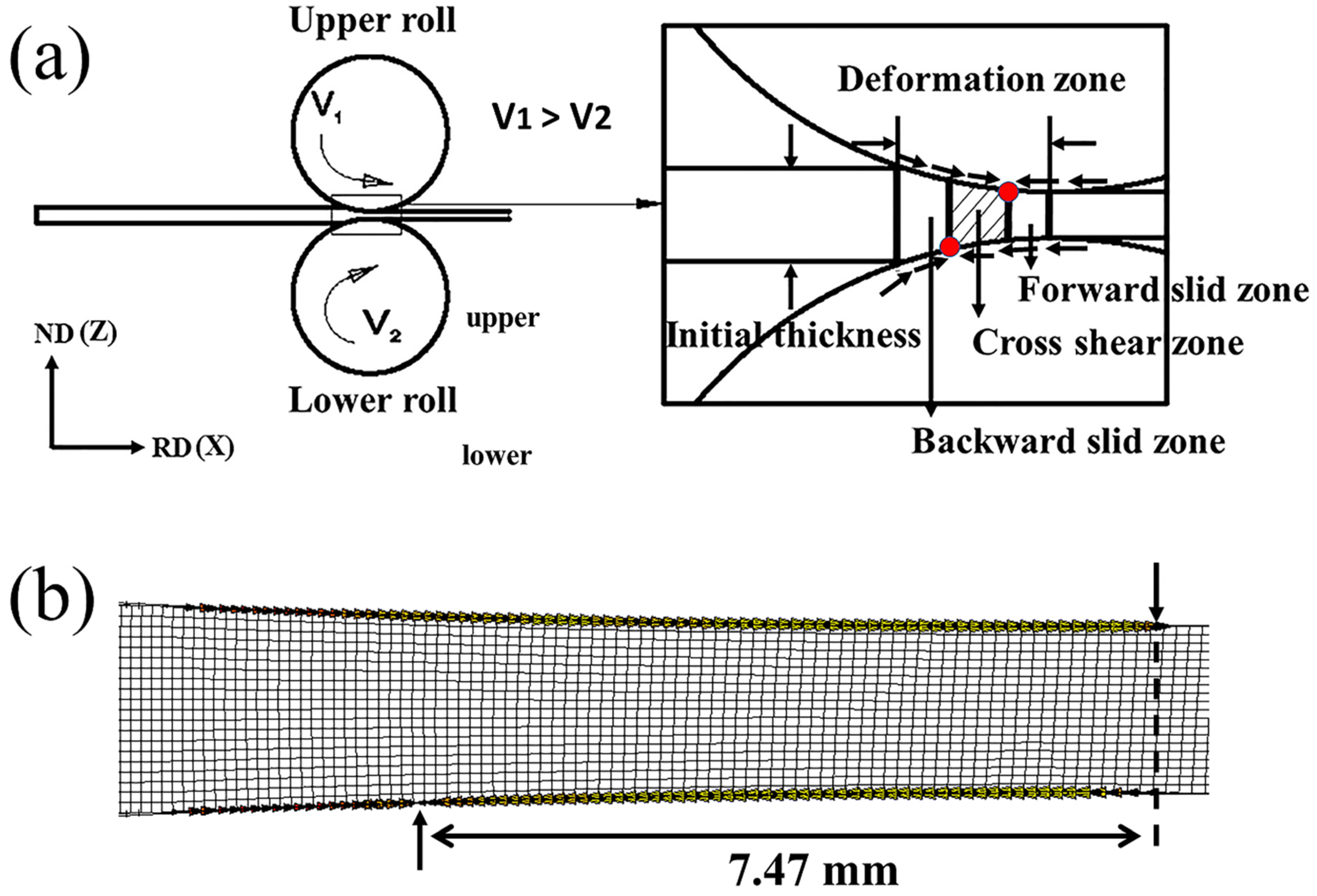

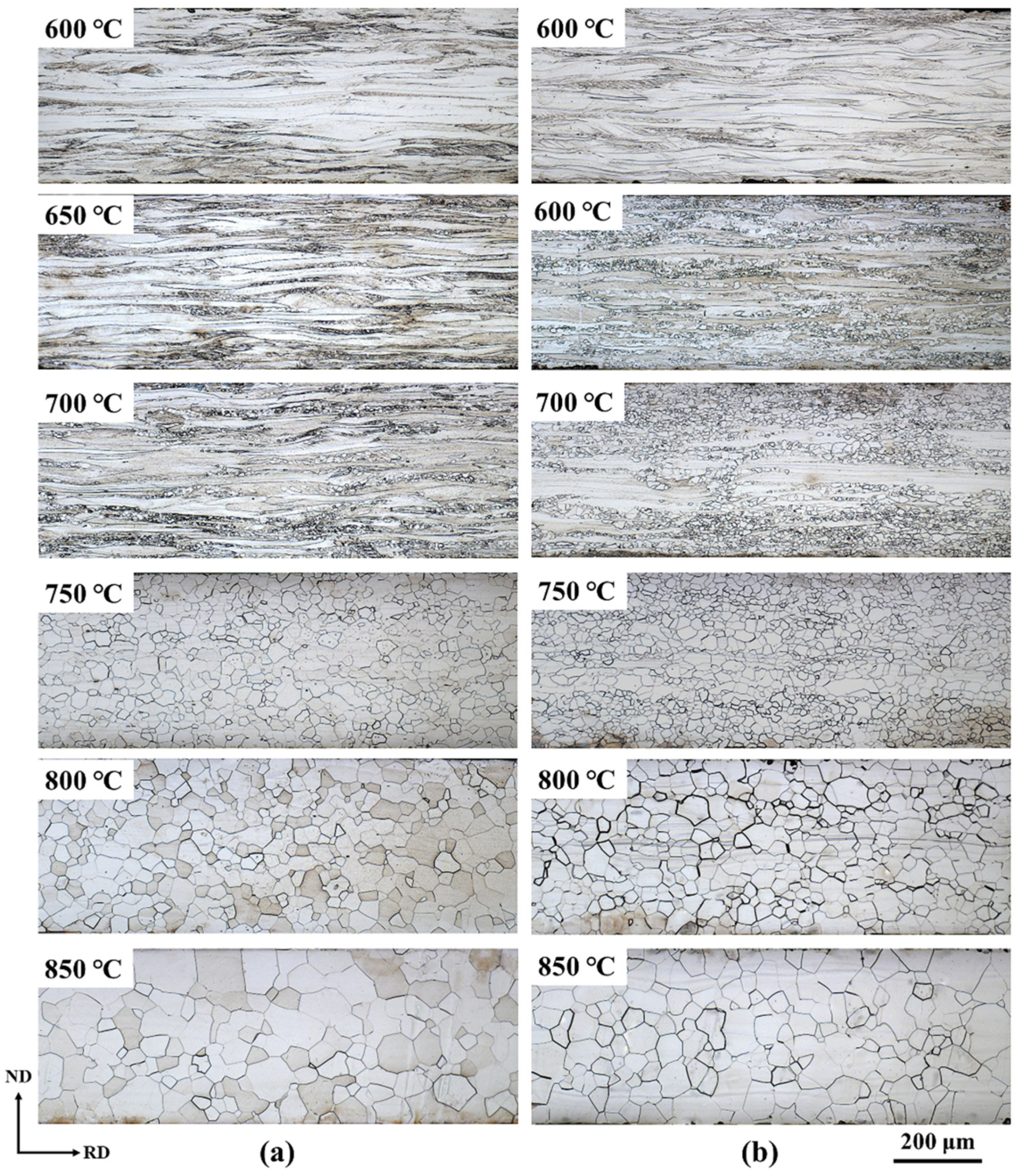



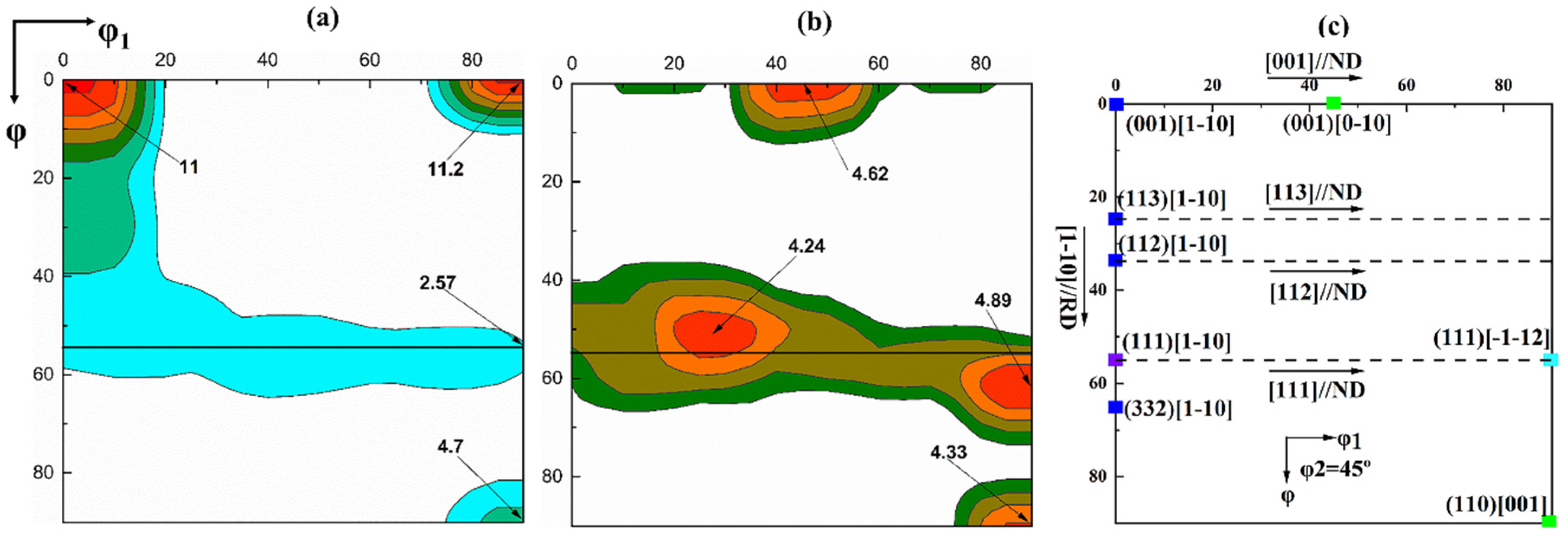
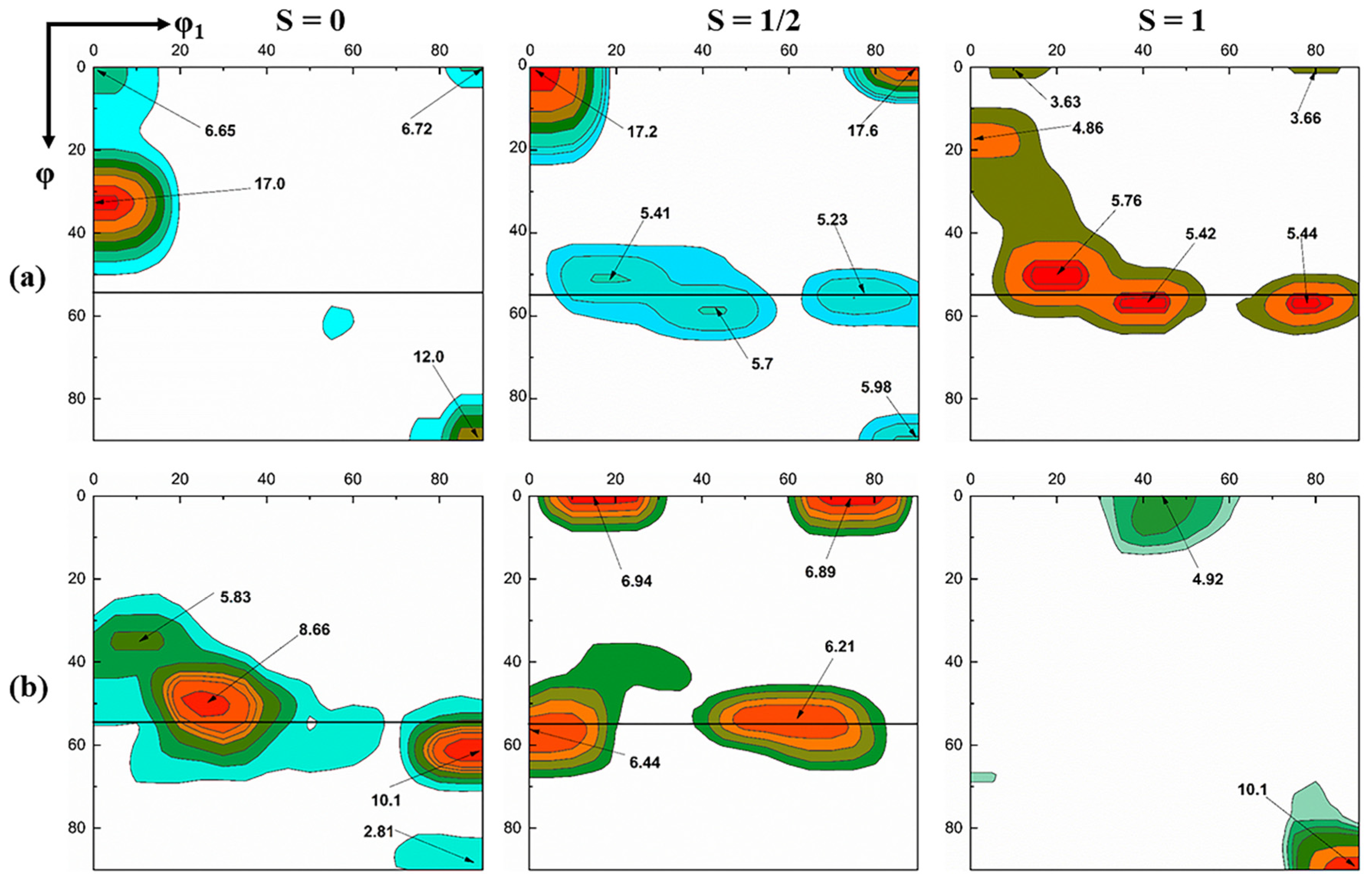

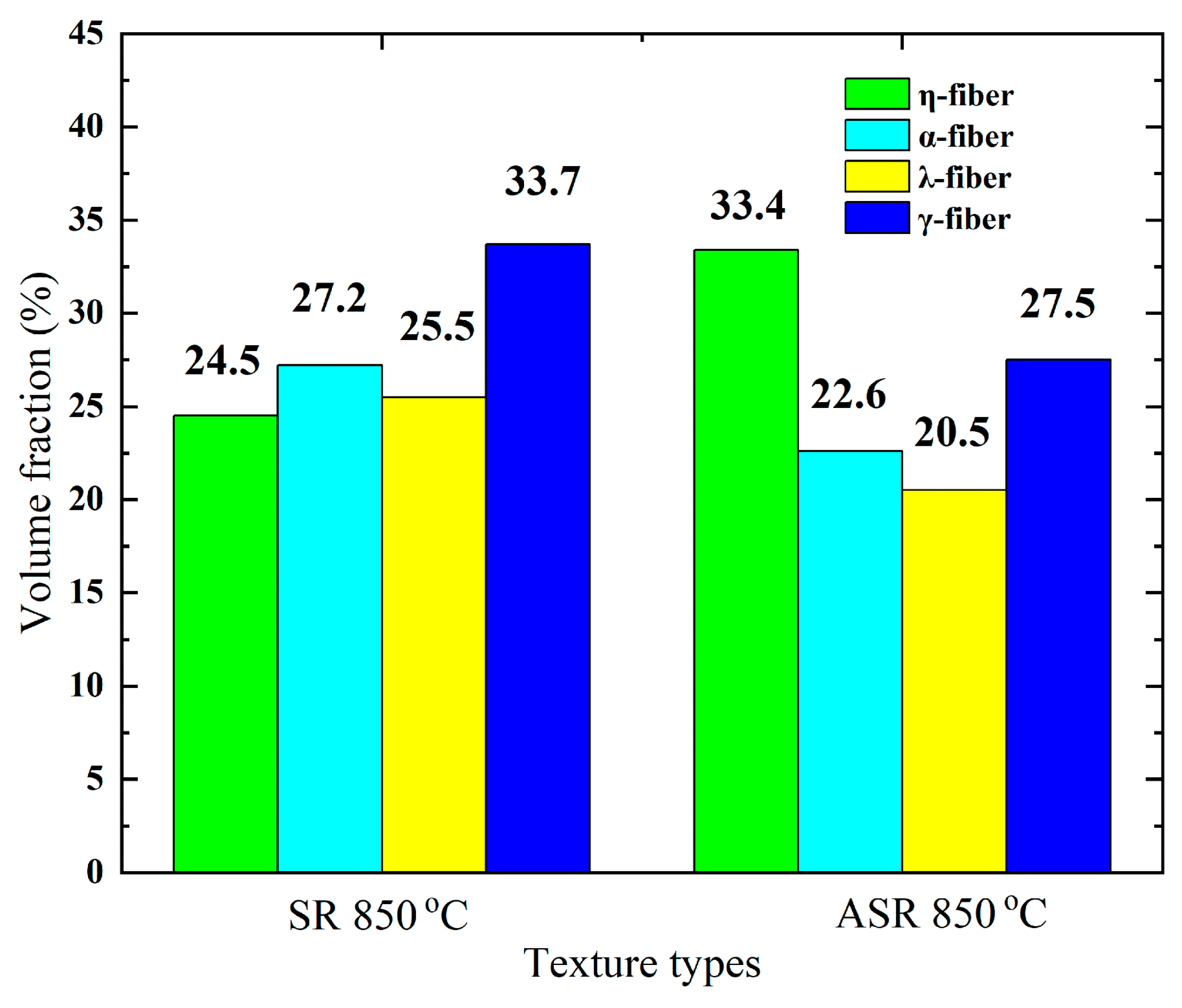

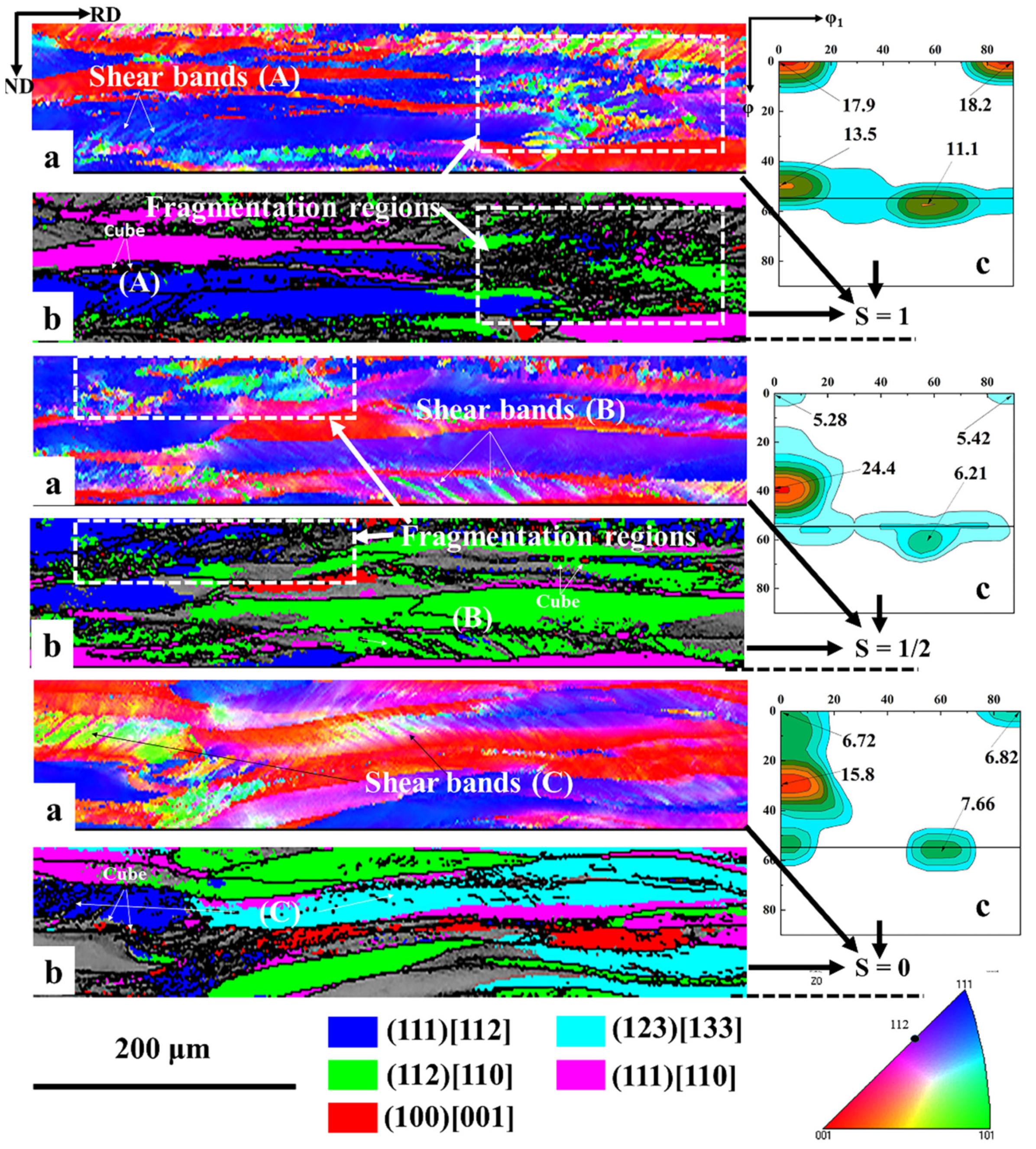
Publisher’s Note: MDPI stays neutral with regard to jurisdictional claims in published maps and institutional affiliations. |
© 2020 by the authors. Licensee MDPI, Basel, Switzerland. This article is an open access article distributed under the terms and conditions of the Creative Commons Attribution (CC BY) license (http://creativecommons.org/licenses/by/4.0/).
Share and Cite
Fang, Z.; Guo, Y.; Fu, B.; Wei, L.; Chen, J.; Pang, L.; Wang, Z. Effect of Shear Bands Induced by Asymmetric Rolling on Microstructure and Texture Evolution of Non-Oriented 3.3% Si Steel. Materials 2020, 13, 4696. https://doi.org/10.3390/ma13214696
Fang Z, Guo Y, Fu B, Wei L, Chen J, Pang L, Wang Z. Effect of Shear Bands Induced by Asymmetric Rolling on Microstructure and Texture Evolution of Non-Oriented 3.3% Si Steel. Materials. 2020; 13(21):4696. https://doi.org/10.3390/ma13214696
Chicago/Turabian StyleFang, Zhiyong, Yanhui Guo, Bin Fu, Liqun Wei, Jun Chen, Linghuan Pang, and Zemin Wang. 2020. "Effect of Shear Bands Induced by Asymmetric Rolling on Microstructure and Texture Evolution of Non-Oriented 3.3% Si Steel" Materials 13, no. 21: 4696. https://doi.org/10.3390/ma13214696
APA StyleFang, Z., Guo, Y., Fu, B., Wei, L., Chen, J., Pang, L., & Wang, Z. (2020). Effect of Shear Bands Induced by Asymmetric Rolling on Microstructure and Texture Evolution of Non-Oriented 3.3% Si Steel. Materials, 13(21), 4696. https://doi.org/10.3390/ma13214696




